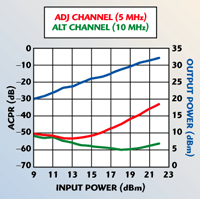
Filtronic Compound Semiconductor has created a new line of power PHEMT devices designed for infrastructure applications. These devices are useable at frequencies from 900 MHz cellular through 3.5 GHz WLL applications. The use of PHEMT technology results in power FETs with superior performance in ACPR and efficiency, both critical in most infrastructure applications.
As a leading supplier to the wireless infrastructure market, Filtronic has been involved in pushing the technology envelope for both the receive and transmit functions in wireless base stations. As part of this effort, Filtronic has developed a GaAs PHEMT power FET technology in its Newton-Aycliffe, UK, wafer fabrication facility, outfitted just seven years ago as a state-of-the-art, six-inch, volume manufacturing wafer fabrication plant. Now power PHEMT devices developed in this facility are being used in the production of infrastructure equipment produced by Filtronic.
Filtronic is now offering a new line of PHEMT power devices to the commercial market. Power FETs with P1dB values of 1, 2, 4 and 10 W have been developed. These devices offer many of the advantages of the products developed for in-house use. The 1, 2 and 4 W devices are available in surface-mount packages. The 4 and 10 W devices are also available in a flange-mount package.
Infrastructure applications require power devices that can meet stringent linearity requirements while operating at the highest efficiency possible. PHEMT devices can help meet this need through their characteristics of high gain, high efficiency and improved linearity under low bias conditions.

Fig. 1 Power transfer characteristics of a 4 W PHEMT.
Figure 1 shows the power transfer curve for the FPD4000AF, a 4 W, flange-mounted device. In the same figure, the gain compression curve makes apparent the PHEMT gain expansion region, which is a factor in its linearity under peak signal conditions.
Figures 2 and 3 show the device performance under WCDMA modulation conditions: the spectral mask under WCDMA modulation, and the ACPR performance versus output power at 5 and 10 MHz offsets.

Fig. 2 Spectral mask of the 4 W PHEMT under WCDMA modulation.

Fig. 3 ACPR performance of the 4 W PHEMT under WCDMA modulation.
Efficiency in an amplifier is a function of both inherent drain efficiency and the gain of the amplifier stage. While PHEMT devices can be biased for excellent linearity under class AB bias conditions, it is also their high gain that contributes to the overall amplifier efficiency. Figure 4 shows the gain of three samples of the FPD4000AS (surface-mount) device, compared to five samples of a leading competitor’s device. Both were tuned for optimum performance in a 2 GHz test fixture.

Fig. 4 Gain comparison between three Filtronic 4 W PHEMTs and five comparable devices from a competitor.
Figure 5 illustrates the linearity advantage of the PHEMT technology from a different viewpoint. This graph focuses on the third-order intermodulation performance under peak signal conditions for Filtronic PHEMT devices versus a leading manufacturer’s MESFET offering. This graph has been normalized so that the horizontal axis shows the backoff from P1dB and the performance shown is truly a measure of device linearity and not simply a measure of the gate periphery of the devices. It is apparent that the FPD4000AS offers a linearity advantage compared to the MESFET at power levels from 5 dB backoff through compression.

Fig. 5 IM3 versus backoff from PldB compression point.
The advantages of high gain, efficiency and linearity come even more strongly into play at higher frequencies, such as the emerging WiMax applications at 2.5 to 2.7 GHz and 3.5 GHz. Filtronic offers evaluation boards for customer requirements in these bands, as well as cellular and PCS frequencies.
Filtronic Compound Semiconductors,
Cupertino, CA
(408) 850-5790;
Newton Aycliffe,
Co. Durham, UK
+44 1325-301111,
www.filtronic.com.
